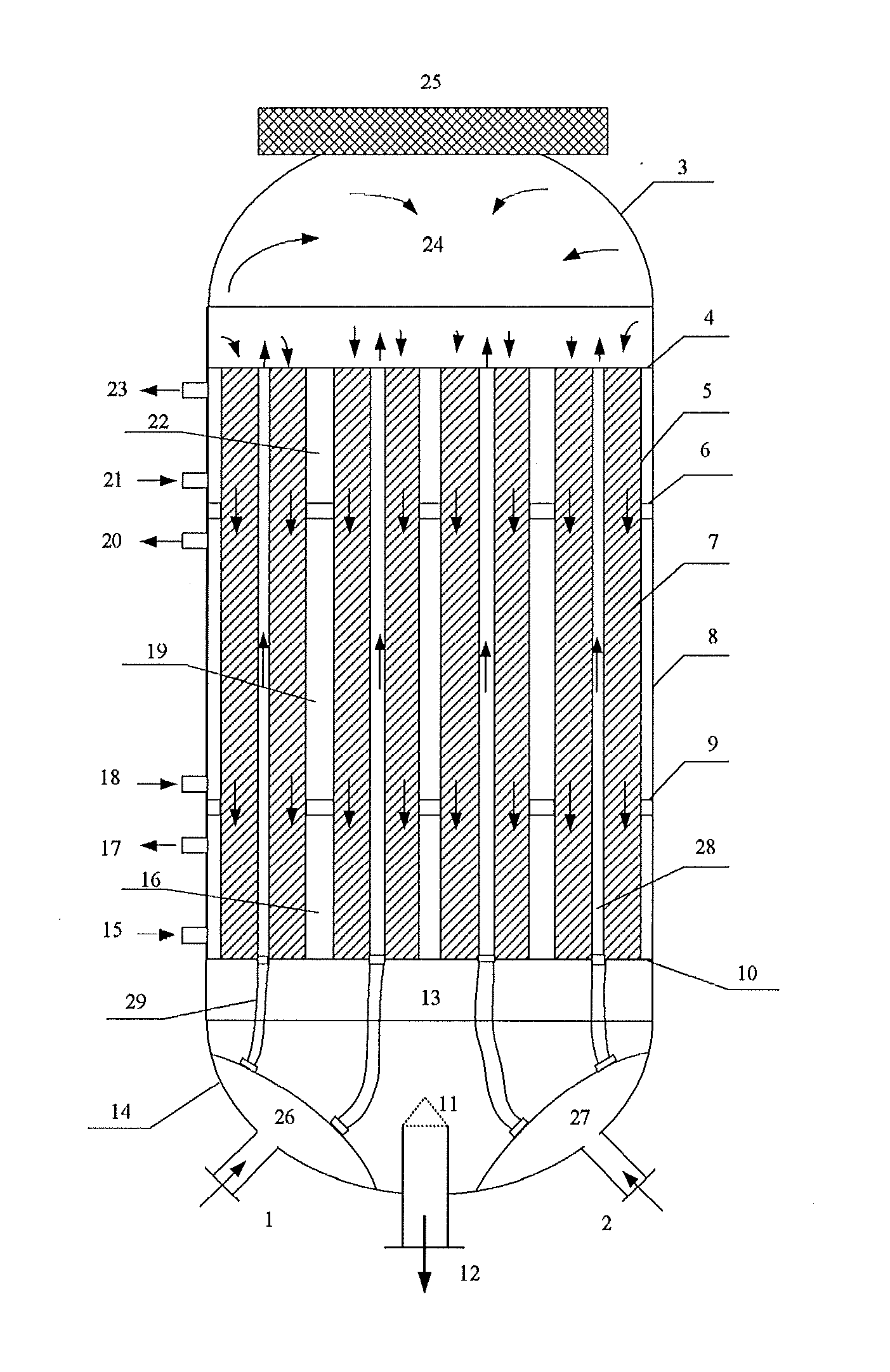Method for the production of ethylene glycol
a production method and technology of ethylene glycol, applied in the field of high-efficiency methods for producing ethylene glycol, can solve the problems of affecting the cost of ethylene glycol production, increasing market demand cannot be satisfied, and high energy consumption, so as to achieve less reaction heat, more reaction heat, and higher reaction rate
- Summary
- Abstract
- Description
- Claims
- Application Information
AI Technical Summary
Benefits of technology
Problems solved by technology
Method used
Image
Examples
example 1
[0032]A catalyst comprising 20 parts of Cu, 5 parts of Bi and 2 parts of W, based on the total parts by weight of the catalyst, was prepared by using silica having a specific surface area of 150 m2 / g as the support material according to the following procedure: a) a solution of mixed nitrates of Cu, Bi and W (purchased from Shanghai Guoyao Group, 99.9% purity, the same below) and a solution of sodium carbonate (purchased from Shanghai Guoyao Group, 99.9% purity, the same below) with the desired concentration were prepared; b) the above solutions were co-precipitated at 70° C. with continuous stirring, and the pH value was 6 at the end of the precipitation; c) the precipitated slurry was washed with deionized water repeatedly until no Na+ was detected, and then the silica support material and a silica sol adhesive having a concentration of 10% were added and slurryed; d) the resultant was extruded through a twin-screw extruder into a cloverleaf-shaped catalyst; and e) the catalyst th...
example 2
[0035]Catalyst B comprising 30 parts of Cu, 10 parts of Bi and 1 part of W was prepared according to the steps and under the conditions as described in Example 1, except that the average specific surface area of the silica support material used was 280 m2 / g. The resulted catalyst had a pore volume of 0.4 ml / g, an average pore diameter of 6 nm, a specific surface area of 260 m2 / g, and a crushing strength of 120 N / cm.
[0036]A required amount of the obtained Catalyst B was weighted and loaded into the reactor shown in the figure. The first, second and third heat-exchange media used were saturated water steams with different pressures, so as to achieve a temperature difference for controlling the temperature of the catalyst bed in the reactor. In addition, outer and inner tubes configured in a double-tube structure were used to facilitate the heat exchange of the catalyst. The first partitioning plate was located below the cover plate of the reactor with a distance therefrom of ⅕ of the ...
example 3
[0038]Catalyst C comprising 30 parts of Cu, 3 parts of Bi and 15 part of W was prepared according to the steps and under the conditions as described in Example 1, except that the support material used was a mixture of silica and alumina. The resulted catalyst had a pore volume of 0.5 ml / g, an average pore diameter of 8 nm, a specific surface area of 230 m2 / g, and a crushing strength of 100 N / cm.
[0039]A required amount of the obtained Catalyst C was weighted and loaded into the reactor shown in the figure. The first, second and third heat-exchange media used were saturated water steams with different pressures, so as to achieve a temperature difference for controlling the temperature of the catalyst bed in the reactor. In addition, outer and inner tubes configured in a double-tube structure were used to facilitate the heat exchange of the catalyst. The first partitioning plate was located below the cover plate of the reactor with a distance therefrom of 1 / 7 of the length of the react...
PUM
| Property | Measurement | Unit |
|---|---|---|
| Temperature | aaaaa | aaaaa |
| Temperature | aaaaa | aaaaa |
| Fraction | aaaaa | aaaaa |
Abstract
Description
Claims
Application Information
 Login to View More
Login to View More - R&D
- Intellectual Property
- Life Sciences
- Materials
- Tech Scout
- Unparalleled Data Quality
- Higher Quality Content
- 60% Fewer Hallucinations
Browse by: Latest US Patents, China's latest patents, Technical Efficacy Thesaurus, Application Domain, Technology Topic, Popular Technical Reports.
© 2025 PatSnap. All rights reserved.Legal|Privacy policy|Modern Slavery Act Transparency Statement|Sitemap|About US| Contact US: help@patsnap.com


